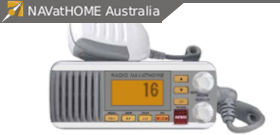VHF Radio Operators Course
Short Range Radio Operators Certificate of Proficiency
The VHF Marine Radio is the most commonly installed radio equipment on marine vessels. It is the corner stone of radio communication and provides an essential safety service. The radio has numerous benefits over the handy mobile phone including increased range, wide area broadcasting, and not reliant on a third party network.
In many areas, it is now a requirement that a vessel going more than a few natuical miles offshore is required to have a VHF radio onboard, and if a VHF radio is installed, you are required to have a VHF license. You are also required to have a VHF license in order to register a vessel with an MMSI number.
The NAVatHOME Australia VHF Radio Operators Course is the only course that uses interactive speech recognition with realistic simulated systems to allow you to actually practice your broadcasts, gain confidence, and get a response appropriate to your call. It is also the only online course that goes through a simulated setup of a DSC radio AND then use DSC to interact with another radio - things that you can not do in the real world for practice. It is an incredible bit of fun, and as close as you can get to working with a real radio without having one!
To obtain the SRROCP, you will need to complete the Australian Maritime College issued multiple choice exam and a practical demonstration. Depending on your enrolment, this will either be included in the course, or taken separately.
Certification:
Short Range Radio Operators Certificate of Proficiency
Course Only - $125AUD
Complete Course & Online AMC Exam - $245AUD
- - Online E-Learning Course
- - Interactive Radio Simulator
- - Realtime Speech Recognition
- - DSC Simulator
- - Phonetic Glossary with audible pronounciation
- - Downloadable Handouts
- AMC Invigilated Online Assessment (for course with exam)
Compatibility
Voice Recognition is compatible with Chrome, Edge, Safari Desktop and Laptop browsers.
All Mobile devices.
Try our online demonstration of our simulators.

Who is this course for?
- Any operator of a VHF Marine Radio.
- Operators of 27MHz Radios that want to learn correct procedures.
- Owners of vessels that have a VHF radio installed.
- Operators who require a VHF radio license for Yachtmaster or Commerical Operation.
What the course covers:
- Overiew of Principles
- VHF Radio Wave Propagation
- Operational Frequencies
- Priority of Communications
- Legislative Regulations
- Phonetic Glossary
- Radio Abbreviations
- Shore Stations and Coast Stations
hide
- Overview of Basic Electrical Circuits.
- Circuit Protection
- Marine Batteries
- Battery Maintenance
- Emergency Battery Options
hide
- Interconnected Components
- Typical Unit Controls
- Typical Handset Controls
- VHF Repeaters
- Overview of Satellite Communications
hide
- Demonstration of Procedures
- Elements of a Radio Call
- Initiating a Radio Call
- Responding to a Radio Call
- Details of the Message
hide
- Mayday Calling Procedures
- Mayday Relay Procedures
- PanPan Calling Procedures
- Securtite (Safety) Calls
- Simulation of Priority Calls
hide
- Overview of DSC
- Setup of DSC Paramters in a VHF Radio
- Activation of DSC Alerts using the Interactive Simulators
- Make a Routine DSC call using the Interactive Simulators
- Overview of AIS
- Accessing AIS Data
hide
- EPIRB Operation
- RADAR Transponders
- AIS Personal Locator Beacons
hide
How is the course delivered
The course is provided by Navathome Australia using our own uniqe and copyrighted Online Interactive Radio Simulators accompanied by presentation material.
Support and Extras
All support is provided by Navathome Australia. Students will have full access to NAVatHOME supporting resources.
- Phonetic Radio Glossary where terms are expland and have a phonetic pronouciation guide.
- Downloadable Cheet Sheets
- Downloadable Channel Wheel Sheet